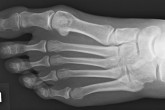
Tendons are the fibrous and flexible bands that connect muscles to bone—and when they’re inflamed, you can’t help but notice. “Tendonitis” (or tendinitis) is the official term used to describe tendon pain and inflammation. This condition can occur suddenly, or it can have a slow onset in response to overuse from repetitive movements, like those associated with certain jobs or hobbies.
If tendon pain is interfering with your daily routine, you should see a healthcare professional to get your injury checked out. In the meantime, here are five tendonitis home remedies:
1.) Take a Load Off
If you have tendonitis, it’s best to take a break from the activity that’s causing (or aggravating) it. This doesn’t mean you have to give up being active altogether; however, it’s important to rest for at least several days (if not weeks). Activities like biking and swimming are great low-impact exercise options to keep you moving while your tendons heal.
2.) Apply Ice
Tendonitis pain and tenderness may occur in your muscles or near a joint. To reduce inflammation, you should apply ice in ten to 15-minute intervals as soon as you notice any pain in these areas. During the first 72 hours after injury, you can repeat your icing routine up to twice per hour. After those first few days, you can apply it as often as you need—as long as it continues to relieve your pain.
3.) Stretch it Out
Even if you’re taking a break from some of your normal activities, you can still continue to stretch your muscles and joints. The key is keeping the stretches gentle to avoid reinjury. Stretching will improve your range of motion and prevent stiffness. And don’t stop once you’re pain-free. Instead, continue stretching to keep your muscles loose and relaxed. Need help with stretching techniques? Find a PT in your area here.
4.) Compress the Area
When your joints are swollen from tendonitis, you can reduce the swelling by wrapping the swollen area with an elastic bandage or compression wrap. Compression also speeds recovery by stimulating the movement of lymph fluid, which transports nutrients that are essential for tissue repair to the site of the injury.
5.) Consider Anti-Inflammatories
If you’re still feeling pain after you’ve rested, iced, stretched, and compressed, then you can try taking ibuprofen or other anti-inflammatory drugs. These medications are available in pill form or as a cream that you can apply directly to your sore spots. Just be careful not to overdo it. While it’s tempting to pop some Advil every time you feel a twinge, masking your symptoms with medication puts you at risk for reinjury. Pain is a good indicator of when enough is enough—and it’s wise to listen to that cue.
To prevent tendon injuries, be sure to warm up properly, stretch, and switch up your regular routines to avoid overuse. If you do find yourself in pain, contact a healthcare provider. Then, take care of yourself at home by resting, icing, stretching, compressing, and taking anti-inflammatory medication in appropriate doses.


